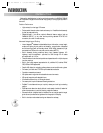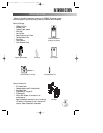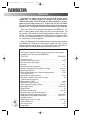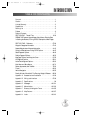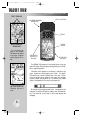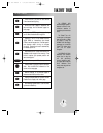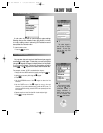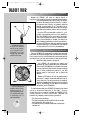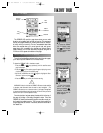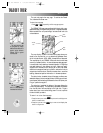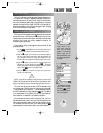
TAKEOFF TOUR
The 24 GPS satellites are
constantly moving, orbiting
the earth twice a day. In
order to calculate your posi-
tion, the GPS receiver needs
to continuously “see” at
least three satellites.
12
ACQUIRING SATELLITE SIGNALS
Because the GPSMAP 195 relies on satellite signals to
provide you with navigation guidance, the receiver’s antenna needs to
have an unobstructed, clear view of the sky for best per-
formance. What exactly does this mean? In a nutshell,
the antenna’s view of the sky will generally determine
how fast you get a position fix, or if you get a fix at all.
GPS signals are relatively weak and do not travel through
large obstructions made of metal or wood, for example.
Once the GPS has calculated a position fix, you’ll
typically have anywhere from five to nine satellites in
view. Your GPSMAP 195 will continuously use all satel-
lites in view to update your position. If some of the satel-
lites in view are blocked, or “shaded,” the receiver can
use the remaining satellites to maintain the position fix.
Although a GPS receiver needs four satellites to provide
a three-dimensional fix (includes altitude), the GPSMAP
195 may obtain a 2D fix with only three satellites.
Take your GPSMAP 195 outside and find a large, open area (away
from towers, buildings and hangars) that has a clear view of the sky
from horizon to horizon. Hold the receiver at a comfortable height, at
arm’s length from your body, with the built-in antenna (the top part
above the display) parallel to the ground.
Your GPSMAP 195 calculates your position and
movement by tracking signals sent from GPS satellites.
Each of the 24 GPS satellites circle the earth twice a day
in a very precise orbit and transmit information back to
earth. In order to determine a position fix, your GPS
receiver needs to continuously “see” at least three
satellites.
Because a GPS receiver can only see satellites above
the horizon, it needs to know what satellites to look for
at any given time. By using an almanac (a timetable of
satellite numbers and their orbits) stored in the receiver’s
memory, the GPSMAP 195 can determine the distance
and position of any GPS satellite.
To use this almanac data, your GPSMAP 195 needs to know where
you are, or be given the opportunity to “find itself.” Once you
initialize the unit to this position, thereafter the GPSMAP 195 will
normally compute a fix within a few minutes. Remember, this
process is only necessary under the following conditions:
• First-time use from the factory;
• The receiver has been moved over 500 miles from the last
calculated position with power off; or
• The receiver’s memory has been cleared and all stored data
has been lost.
INITIALIZING THE RECEIVER
The GPSMAP 195’s view
of the sky will determine
how fast you get a position
fix, or if you get a fix at all.
GPS signals do not pass
through large obstructions
made of wood or metal.
gps 195 manual C 7/1/99 4:48 PM Page 12



